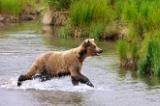Plants and Animals
By Bruce A. Stein
A dazzling array of life inhabits the nation’s lands and waters. From iconic wildlife symbols like grizzly bears and gray wolves, to more humble creatures such as the littlewing pearlymussel (Pegias fibula), America’s plant and animal species constitute the living fabric of our natural habitats and open spaces. Although open spaces are valued for many reasons, their role in sheltering and sustaining abundant wildlife is of primary importance for many people. Determining which lands and waters are most significant for maintaining healthy ecosystems—and the many services they provide to humans—requires an understanding of the varied plant and animal species that represent the fundamental components of these ecosystems.
With its diverse geography and climate, the United States harbors a rich biological heritage; more than 200,000 species have been documented and described by scientists, and many more continue to be discovered. Surprising to many, the United States is a world center of diversity for many types of plants and animals, and accordingly plays an important role in the conservation of world’s biodiversity.
Unfortunately, many U.S. plants and animals have declined dramatically over the past two centuries as a result of massive conversion of the nation’s landscapes and other human activities. Indeed, more than one hundred U.S. species already are extinct, and as much as one-third of the nation's species of flora and fauna are at increased risk of extinction. Without concerted and strategic action to protect the lands and waters on which these species depend, we stand to witness a wave of extinctions unparalleled since the demise of the dinosaurs.
The nation’s plant and animal species are not distributed uniformly, however, and for ecological and evolutionary reasons, certain geographic areas are characterized by a greater diversity of plants and animals than others. Coupled with this underlying geographic pattern of diversity, human impacts on our natural heritage have varied from place to place, creating a highly varied geography of risk. Understanding these patterns of both biological richness and risk are important for helping to formulate strategic approaches to open space and ecosystem protection.
Understanding and Conserving Plants and Animals
-
Biodiversity 101
More than 200,000 species of plants, animals, and microbes have been described and named scientifically in the United States. From a conservation perspective, many of the species of greatest interest -- and concern -- are not readily apparent.
-
Geography of Diversity and Risk
Climate, landform, geological history, and human history all interact to express the biological wealth of a region. Identifying the most significant open spaces for protection of plant and animal species requires an understanding of this geography of diversity and risk.
-
Rare and Endangered Species
While some at-risk plants and animals gain formal legal protection under the Endangered Species Act, others are identified as imperiled through a system developed NatureServe and its network of state natural heritage programs. Bruce Stein outlines how both help us understand which species are thriving and which are declining, rare, or even already gone?
-
Conserving Species
Referred to as a "fine filter," the species-centered approach to conservation is designed to protect individual plants and animals that are imperiled by human activities or recognized as having high conservation value. Conservation biologist Reed Noss explains.
Go Straight to Your State
Learn about conservation and open space in your state.









